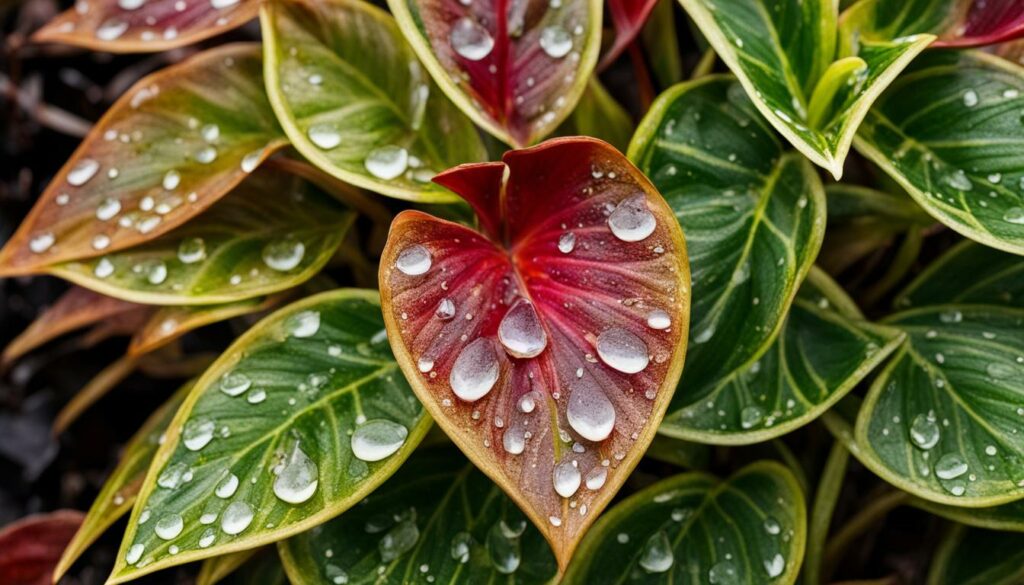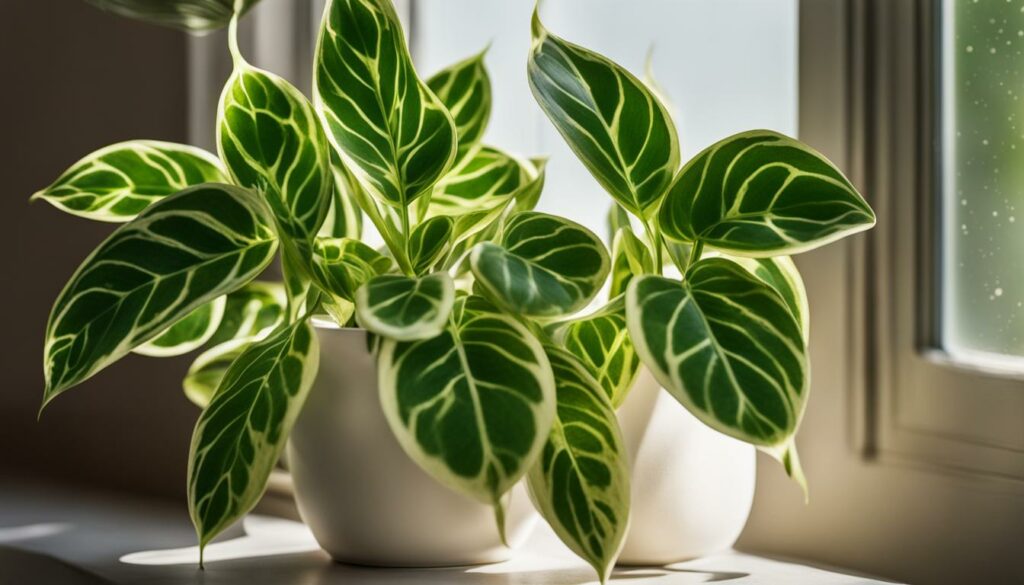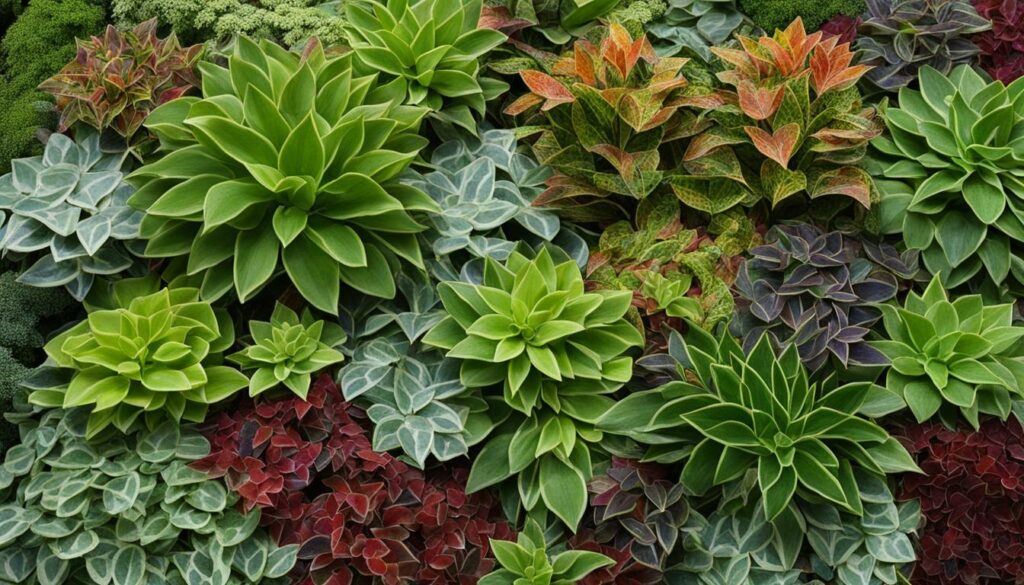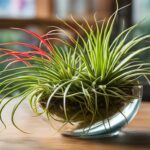Welcome to our Variegated Teardrop Plant Care Guide! If you’re a plant lover looking to add a touch of tropical beauty to your indoor space, then the Variegated Teardrop Plant, also known as Peperomia, is the perfect choice for you. With its stunning foliage and low maintenance needs, this plant is a favorite among indoor gardeners. In this comprehensive guide, we’ll provide you with essential care tips for your Variegated Teardrop Plant, ensuring that it thrives in your home.
Indoor gardening has become increasingly popular, and the Variegated Teardrop Plant is a top pick for many. This tropical beauty, native to Mexico, South America, and the Caribbean, boasts thick, fleshy leaves in a range of textures, colors, and shapes. The combination of red, green, gray, and purple foliage makes it an eye-catching addition to any room.
One of the advantages of the Variegated Teardrop Plant is its low maintenance nature. It doesn’t require constant attention or extensive care routines. By providing the right light, water, and soil conditions, you can ensure the health and vitality of your plant.
So, if you’re ready to embark on your Variegated Teardrop Plant journey, let’s dive into the care tips that will keep your plant happy and thriving indoors!
Light Requirements for Variegated Teardrop Plants
Variegated Teardrop Plants thrive in medium to bright indirect light. They should be placed in a spot that receives sufficient light but is protected from direct sunlight, as it can damage their leaves. Ideally, place your plant in front of a west- or east-facing window or a few feet back from a south- or north-facing window. Insufficient light can result in fewer leaves, leaf drop, and dull coloration. It’s important to find the right balance of light to maintain the vibrant foliage colors of your Variegated Teardrop Plant.
To assess lighting conditions, you can use the shadow test. If the shadow cast by your hand is sharp and well-defined, the light may be too bright. However, if the shadow is barely visible or blurry, it may indicate insufficient light. Observing the leaves can also provide clues. If the plant reaches towards the light source or the leaves become elongated and pale, it may need more light. On the other hand, if the leaves turn yellow or develop brown spots, it may be receiving too much direct sunlight.
It’s worth noting that Variegated Teardrop Plants can tolerate lower light conditions, but this may result in slower growth and less vibrant foliage colors. If you’re unable to provide sufficient natural light, you can supplement with artificial lighting. LED grow lights or fluorescent lights can be used to provide the necessary light intensity and spectrum for optimal growth.
Watering Guide for Variegated Teardrop Plants
Proper watering is essential for the health and vitality of your Variegated Teardrop Plant. Follow these guidelines to ensure you’re providing the right amount of water:
- Allow the top two inches of soil to dry out before watering your plant again. This will prevent overwatering and the risk of root rot.
- Avoid letting your plant sit in standing water, as it can lead to waterlogged roots. Make sure the pot has drainage holes to allow excess water to escape.
- When watering, thoroughly saturate the soil until water trickles out of the drainage holes. This ensures that the entire root ball is adequately moistened.
- Monitor the moisture level of the soil by inserting your finger about an inch into the soil. If it feels dry, it’s time to water. If it still feels moist, wait a bit longer before watering again.
Remember that every environment is different, so the frequency of watering may vary depending on factors such as temperature, humidity, and the size of the pot. It’s always better to underwater than overwater your Variegated Teardrop Plant.

“Proper watering is essential for the health and vitality of your Variegated Teardrop Plant.”
Soil Requirements for Variegated Teardrop Plants
When it comes to providing the best soil for your Variegated Teardrop Plants, it’s important to create a well-draining environment that retains moisture effectively. These plants thrive in loose potting mixes that allow excess water to escape easily, preventing the risk of waterlogged roots. A suitable soil mixture can be created by combining regular potting soil with coco coir or perlite for improved aeration.
A popular alternative to traditional potting soil is an orchid potting medium, which closely mimics the natural growing conditions of Variegated Teardrop Plants. The airy texture of orchid mix promotes root health and prevents issues such as root rot. It’s essential to select a soil blend that allows water to flow through easily while still retaining enough moisture to keep the plants hydrated.
Creating optimal soil conditions is crucial for the overall health and growth of Variegated Teardrop Plants. By choosing the right soil mixture, you can ensure that your plants receive the necessary nutrients and moisture, promoting vibrant foliage and vigorous growth.
| Soil Requirements | Best Soil for Variegated Teardrop Plants |
|---|---|
| Loose and well-draining | Regular potting soil mixed with coco coir or perlite |
| Moisture-retaining | Orchid potting medium for improved aeration |
| Absorbs excess water | Provides nutrients for healthy growth |
Choosing the Right Container
Aside from selecting the ideal potting mix, it’s important to choose the right container for your Variegated Teardrop Plants. Opt for pots with drainage holes in the bottom to allow excess water to escape, preventing the risk of waterlogging. This helps maintain the proper balance of moisture in the soil and prevents root rot.
Additionally, consider the size of the container. Variegated Teardrop Plants prefer slightly snug containers that accommodate their root systems without leaving excess space. A container that is too large can lead to overwatering and slow the plant’s growth. Choose a container that provides just enough space for the plant’s roots to grow comfortably.
Ensuring Proper Drainage
Proper drainage is crucial for the health of your Variegated Teardrop Plants. In addition to selecting a well-draining potting mix and container, you can further enhance drainage by adding a layer of small pebbles or broken pottery pieces at the bottom of the pot. This creates a barrier between the soil and the drainage holes, preventing them from becoming clogged and ensuring excess water flows out effectively.
In conclusion, the soil requirements for Variegated Teardrop Plants involve creating a loose and well-draining environment while retaining adequate moisture. By selecting the right potting mix, choosing suitable containers, and ensuring proper drainage, you can provide the optimal soil conditions that promote the health and vitality of your Variegated Teardrop Plants.
Temperature and Humidity for Variegated Teardrop Plants
Proper temperature and humidity levels are essential for the health and well-being of Variegated Teardrop Plants. Understanding their temperature requirements and humidity needs is crucial to ensure their optimal growth and prevent any potential issues. Let’s explore the ideal conditions for these beautiful tropical plants.
Variegated Teardrop Plants thrive in warm temperatures ranging from 65°F to 75°F (18°C to 24°C). It’s important to keep them away from cold drafts or extreme temperature fluctuations, as they are not frost-tolerant. Maintaining a consistent temperature within their preferred range will promote healthy foliage and overall plant vigor.
Humidity is another important factor for Variegated Teardrop Plants. These plants naturally grow in tropical regions with medium to high humidity levels, so replicating those conditions indoors is beneficial. Aim for a humidity level of around 50% to 60%. You can increase humidity by placing your plant in a naturally humid room, such as a bathroom, or by using a humidifier. Misting the leaves regularly can also help to boost humidity and prevent them from drying out.
| Temperature | Humidity |
|---|---|
| 65°F to 75°F (18°C to 24°C) | Around 50% to 60% |
Remember that maintaining appropriate temperature and humidity levels is essential for the overall health and well-being of your Variegated Teardrop Plant. By providing them with the right environment, you can enjoy their lush foliage and vibrant colors for years to come.

Pruning and Propagation Tips for Variegated Teardrop Plants
Pruning is an essential part of caring for Variegated Teardrop Plants. By trimming back leggy growth, you can promote bushier and more compact growth. To prune your plant, carefully pinch or cut the stems just above a leaf node. This will encourage branching and result in a fuller appearance. Remember to use clean and sharp pruning shears to prevent any damage to the plant.
Propagation of Variegated Teardrop Plants is relatively easy and can be done through stem cuttings. Select a healthy stem with at least an inch of the stem from the mother plant. Make a clean cut just below a leaf node and remove any leaves from the lower part of the stem. Place the cutting in a container filled with well-draining potting soil and create a mini-greenhouse environment by covering it with plastic wrap or using a propagation tray. Keep the soil lightly moist and provide indirect light. Within a few weeks, roots should start to form, and you can then transplant the cutting into a larger container.
Tips for Successful Pruning and Propagation:
- Prune your Variegated Teardrop Plant in the early spring to encourage new growth.
- Always use clean and sharp pruning shears to prevent the spread of diseases.
- When propagating, choose healthy stems and provide the right conditions for root formation.
- Keep the soil lightly moist during propagation, but avoid overwatering.
- Transplant the rooted cuttings into well-draining potting soil once they have established roots.
By following these pruning and propagation tips, you can keep your Variegated Teardrop Plant healthy and propagate new plants to expand your collection or share with fellow plant enthusiasts.
Common Varieties of Variegated Teardrop Plants
If you’re looking to add some variety to your indoor garden, there are several different types of Variegated Teardrop Plants to choose from. Each variety offers unique foliage colors and patterns, ensuring there is a plant to suit every aesthetic preference. Here are some popular varieties to consider:
P. obtusifolia (Baby Rubber Plant)
This variety of Variegated Teardrop Plant, also known as the Baby Rubber Plant, features thick, rubbery leaves with beautiful variegation. The leaves are often a mix of green and cream colors, adding a touch of elegance to any space.
P. verticillata ‘Belly Button’ (Baby Tears Plant)
The ‘Belly Button’ variety of Variegated Teardrop Plant, also known as the Baby Tears Plant, is a compact and trailing plant with small, round leaves. The leaves have a unique pattern of green and white, resembling delicate tears, hence the name.
P. metallica var. Colombiana
This variety of Variegated Teardrop Plant, also known as the Colombiana, features metallic green leaves with dark purple undersides. The contrast between the vibrant green and deep purple makes it a striking addition to any plant collection.
P. nitida (Cupid Peperomia)
The Cupid Peperomia variety of Variegated Teardrop Plant is known for its heart-shaped leaves. The leaves have a glossy green color with creamy white edges, creating a charming and romantic appearance.
P. caperata ‘Suzanne’
The ‘Suzanne’ variety of Variegated Teardrop Plant, also known as the Caperata, features textured leaves with a quilted and crinkled appearance. The leaves have a beautiful combination of green, silver, and red, adding depth and texture to any space.
These are just a few examples of the many different varieties of Variegated Teardrop Plants available. Each variety offers its own unique charm and can bring a touch of nature’s beauty into your home. Whether you prefer the glossy leaves of the Cupid Peperomia or the metallic sheen of the Colombiana, there is sure to be a variety that catches your eye.

| Variegated Teardrop Plant Variety | Description |
|---|---|
| P. obtusifolia (Baby Rubber Plant) | Thick, rubbery leaves with green and cream variegation |
| P. verticillata ‘Belly Button’ (Baby Tears Plant) | Compact and trailing plant with small, round leaves; green and white variegation |
| P. metallica var. Colombiana | Metallic green leaves with dark purple undersides |
| P. nitida (Cupid Peperomia) | Glossy green leaves with creamy white edges; heart-shaped |
| P. caperata ‘Suzanne’ | Textured leaves with quilted and crinkled appearance; green, silver, and red variegation |
Conclusion
So there you have it, the complete care guide for your Variegated Teardrop Plant! With its low maintenance and striking foliage, this plant is a perfect addition to any indoor garden. By following these care instructions, you can ensure that your Variegated Teardrop Plant thrives and remains healthy.
Remember to provide your plant with medium to bright indirect light, allowing it to bask in the sunlight without being scorched. Watering is crucial, so make sure to allow the top two inches of soil to dry out before giving it a good soak. And speaking of soil, a well-draining potting mix with good moisture retention is the way to go.
Don’t forget about the temperature and humidity! Keep your Variegated Teardrop Plant happy by maintaining a warm environment, between 65°F and 75°F, and providing medium to high humidity levels. You can achieve this by placing your plant in a naturally humid room or using a tray of pebbles and water to increase the moisture in the air.
With a little pruning in the spring and the option to propagate through stem cuttings, you can shape and expand your Variegated Teardrop Plant collection. And don’t forget about the various varieties available, each offering its unique beauty for you to enjoy.
So go ahead, take care of your Variegated Teardrop Plants, and watch them thrive as they bring a touch of nature and beauty to your indoor space!
FAQ
How much light does a Variegated Teardrop Plant need?
Variegated Teardrop Plants thrive in medium to bright indirect light. Place them in a spot that receives sufficient light but is protected from direct sunlight.
How often should I water my Variegated Teardrop Plant?
Allow the top two inches of soil to dry out between waterings. Water your plant thoroughly when the soil is dry, but avoid letting it sit in standing water.
What type of soil should I use for my Variegated Teardrop Plant?
Variegated Teardrop Plants prefer a loose and well-draining potting mix. A mixture of regular potting soil and coco coir or perlite works well.
What temperature and humidity levels are ideal for Variegated Teardrop Plants?
Variegated Teardrop Plants prefer warm temperatures between 65°F to 75°F and medium to high humidity levels. Protect them from cold drafts and consider placing them in a naturally humid room or using a tray of pebbles and water to increase humidity.
How do I prune and propagate my Variegated Teardrop Plant?
Lightly prune your plant in the early spring to correct leggy or sparse growth. Propagate Variegated Teardrop Plants through stem cuttings by placing a stem in potting soil and creating a mini-greenhouse environment. Roots will form within a few weeks.
What are some common varieties of Variegated Teardrop Plants?
Popular varieties include P. obtusifolia (Baby Rubber Plant), P. verticillata ‘Belly Button’ (Baby Tears Plant), P. metallica var. Colombiana, P. nitida (Cupid Peperomia), and P. caperata ‘Suzanne,’ among others.





